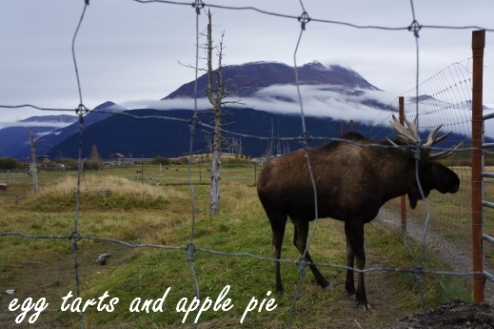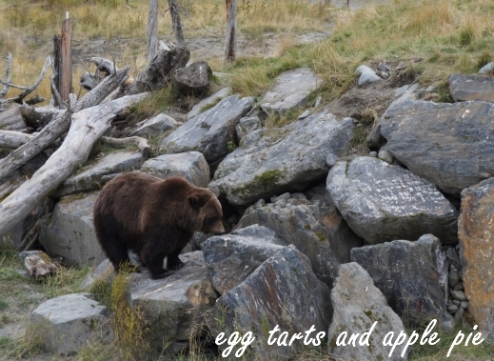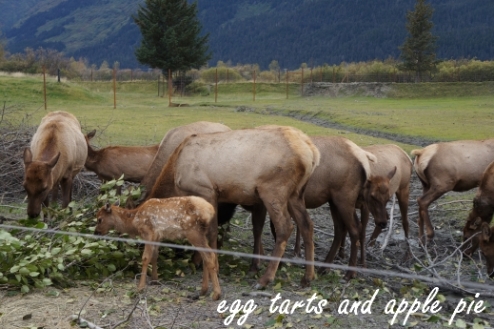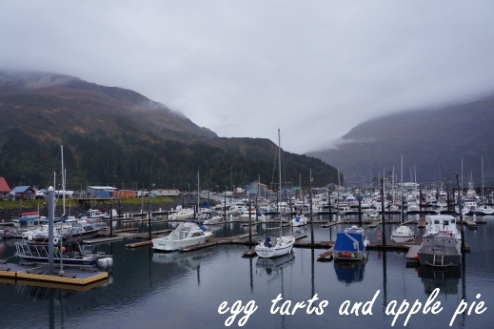“That which the sea breaks against”
Alyeska. The name of America’s northernmost state has its roots in old Aleut. Literally translated, it means “that which the sea breaks against”. It’s a romantic nomen, one which, driving south along the Kenai Peninsula, golden autumnal forest-covered mountains on the left and still, grey waters, rimmed by snowy peaks on the right, aptly captures the breathtaking landscape.
We are on the old Seward Hwy, heading towards Seward from Anchorage. On the first day of my initial visit to Alaska, Luke has planned a whirlwind tour to sample what this remarkable part of the world has to offer. After a quick detour via Girdwood to fuel up on omelette, homefries and coffee (nothing like an all-American breakfast to kickstart a road trip), our first stop is the Alaska Wildlife Conservation Center. Here, a 1.5 mile loop (you can walk or drive) takes you around some expansive enclosures that are home to all manner of Alaska’s native animals.
The ubiquitous moose is probably the most successful species in terms of adapting to urban living. Commonly seen by roads and in populated areas, these park inhabitants do not seem at all fazed by proximity to camera-touting tourists.
An elevated walkway allows the resident brown bears to be viewed from a safe distance. Bears are a real hazard in Alaska, with sightings common along the many miles of trails and in the mountainous surrounds frequented by hikers, and the lure of food drawing them closer to urban areas. We were fortunate not to have had any chance bear encounters on our hikes but it’s always prudent to take precautions. The standard advice for hikers is to make noise as you go to avoid startling any wildlife, have bear spray on hand and keep your distance from any animals that you do see.
A feeding session brings a herd of caribou within selfie distance. Caribou are an important local food source, but are not quite so common in the central-south (the majority of herds are found to the north and west). In Anchorage, you’ll see your fair share of caribou or reindeer* sausage, heavily spiced, with flavour reminiscent of a Pizza Hut meatlovers pizza. Wild game suppliers like Indian Valley Meats, based just south of Anchorage, also stock caribou.
AWCC is also home to a number of wood bison and muskoxen (a cracked skull from a male muskox killed in a head-to-head charge is a good reminder to stand well back from the fence). Once abundant throughout the Arctic north, wood bison and muskoxen had disappeared entirely from Alaska by the 1900s. Extirpation has been attributed to overhunting and habitat change, and the impact of climate change can’t be discounted. Efforts to reintroduce herds to Alaska have seen some success, although wood bison are still not found in the wild. The AWCC plays an active role in the process of rejuvenating numbers and it’s heartening to see quite a few of the woolly bovines thriving at the center.
Representing our feathered friends are a bald eagle and horned owl, both long time residents, brought to the AWCC after being rendered flightless by injuries.
It’s early afternoon by the time we complete the loop, bidding farewell to some adorable baby (plus one feisty teenage) muskoxen and a particularly inquisitive, hyperactive porcupine.
Back on the highway, we take the turn-off at Portage. Luke wonders out loud whether we’ve “timed this right”. We are heading to Whittier, a town to which the only road access is via a one-lane mountain tunnel. Traffic to and from Whittier is managed so that there is a 15 minute window every hour when cars are able to enter the tunnel from a given direction. As luck would have it, we get the green light shortly after passing the tollbooth.
After a slow, 5 minute drive under an unimaginable weight of overlying rock, we emerge on the other side. Completely surrounded by water and mountains, a large train depot occupies one side of the cove, with two residential blocks at the base of the encircling mountains. The dock is full of boats moored for winter and a small strip of shops and diners on the water has closed for the season. There’s a light, mist-like drizzle, or maybe that’s just the dampness from the low-lying fog that has settled in the sheltered cove. It’s eerily beautiful, this grey, dormant town.
We pass some other visitors by the dock with a few muted words of greeting, as if there is a mutual desire to avoid disturbing the quiet. The conversation of a family heading back to the carpark is almost jarring in its loudness and reminds us that it’s almost time to head back through the mountain – or wait another hour. I wonder what happens if you miss the final window.
*Strictly speaking, actual reindeer are not native to Alaska and are the caribou’s European cousin. The term has come into common usage for describing farmed caribou
(References : Alaska Department of Fish and Game, Alaska Wildlife Conservation Center)








